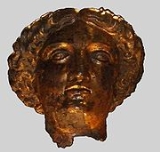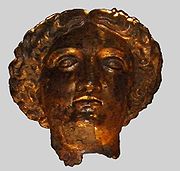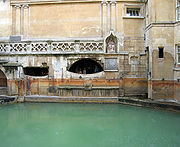
Sulis
Encyclopedia

Celtic polytheism
Celtic polytheism, commonly known as Celtic paganism, refers to the religious beliefs and practices adhered to by the Iron Age peoples of Western Europe now known as the Celts, roughly between 500 BCE and 500 CE, spanning the La Tène period and the Roman era, and in the case of the Insular Celts...
practised in Britain, Sulis was a deity worshipped at the thermal spring of Bath (now in Somerset
Somerset
The ceremonial and non-metropolitan county of Somerset in South West England borders Bristol and Gloucestershire to the north, Wiltshire to the east, Dorset to the south-east, and Devon to the south-west. It is partly bounded to the north and west by the Bristol Channel and the estuary of the...
). She was worshipped by the Romano-British as Sulis Minerva
Minerva
Minerva was the Roman goddess whom Romans from the 2nd century BC onwards equated with the Greek goddess Athena. She was the virgin goddess of poetry, medicine, wisdom, commerce, weaving, crafts, magic...
, whose votive objects and inscribed lead tablets suggest that she was conceived of both as a nourishing, life-giving mother goddess
Mother goddess
Mother goddess is a term used to refer to a goddess who represents motherhood, fertility, creation or embodies the bounty of the Earth. When equated with the Earth or the natural world such goddesses are sometimes referred to as Mother Earth or as the Earth Mother.Many different goddesses have...
and as an effective agent of curses wished by her votaries. The tablets were often written in code, by means of letters or words being written backwards; word order may be reversed and lines may be written in alternating directions, from left to right and then right to left. While most texts from Roman Britain are in Latin, occasional texts may be in a Celtic language. Typically, the text on the tablets offered to Sulis relates to theft; for example, of small amounts of money or clothing from the bath-house. In formulaic, often legalistic, language tablets appeal to the deity, Sulis, to punish the known or unknown perpetrators of the crime until reparation be made. Sulis is typically requested to impair the physical and mental well-being of the perpetrator, by the denial of sleep, by causing normal bodily functions to cease or even by death. These afflictions are to cease only when the property is returned to the owner or disposed of as the owner wishes, often by its being dedicated to the deity. One message found on a tablet in the Temple at Bath (once decoded) reads: "Dodimedis has lost two gloves. He asks that the person who has stolen them should lose his mind and eyes in the temple where she appoint."
Etymology
Although the name "Sulis" appears almost nowhere else outside Bath, she is identified with the SuleviaeSuleviae
In ancient Celtic religion, Sulevia was a goddess worshipped in Gaul and Britain, very often in the plural forms Suleviae or Suleis. Dedications to Sulevia are attested in about forty inscriptions, distributed quite widely in the Celtic world, but with particular concentrations in Noricum, among...
, a group of Celtic goddesses known as the subject of votive inscriptions in the city of Rome and elsewhere; Suleviae has been attested in the epigraphic
Epigraphy
Epigraphy Epigraphy Epigraphy (from the , literally "on-writing", is the study of inscriptions or epigraphs as writing; that is, the science of identifying the graphemes and of classifying their use as to cultural context and date, elucidating their meaning and assessing what conclusions can be...
record from sites at Bath. Suleviae, frequently identified as a plural form of Sulis, is linked to a good many widely revered divine mothers, who frequently appear with two or three primary aspects to their character. On the other hand, the identification of the Suleviae with Sulis has been dismissed by some researchers who suggest that the similarity of the names is coincidental. Suil in Old Irish
Irish language
Irish , also known as Irish Gaelic, is a Goidelic language of the Indo-European language family, originating in Ireland and historically spoken by the Irish people. Irish is now spoken as a first language by a minority of Irish people, as well as being a second language of a larger proportion of...
is "eye" or "gap", with the implication an entrance to the underworld. The usual etymology, however, is that Sulis means "sun" as this is the original form of current Welsh haul—"sun"—and Old Irish suil (from Indo-European *sawel-); cf. Latin sol "sun".
Cult at Bath

Genius loci
In classical Roman religion a genius loci was the protective spirit of a place. It was often depicted in religious iconography as a figure holding a Cornucopia, patera and/or a snake. There are many Roman altars found in Western Europe dedicated in whole or in part to the particular Genius Loci...
of the thermal springs that still feed the spa
Thermal bath
A thermal bath is a warm body of water. It is often referred to as a spa, which is traditionally used to mean a place where the water is believed to have special health-giving properties, though note that many spas offer cold water or mineral water treatments.A thermal bath may be part of a...
baths at Bath, which the Romans
Ancient Rome
Ancient Rome was a thriving civilization that grew on the Italian Peninsula as early as the 8th century BC. Located along the Mediterranean Sea and centered on the city of Rome, it expanded to one of the largest empires in the ancient world....
called Aquae Sulis
Aquae Sulis
Aquae Sulis was a small town in the Roman province of Britannia. Today it is known as Bath, located in the English county of Somerset.-Baths and temple complex:...
("the waters of Sulis"). Her name appears on inscriptions at Bath, but nowhere else. This is not surprising, as Celtic deities often preserved their archaic localisation. They remained to the end associated with a specific place, often a cleft in the earth, a spring, pool or well. The Greeks referred to the similarly local pre-Hellenic deities in the local epithets that they assigned, associated with the cult of their Olympian pantheon at certain places (Zeus Molossos only at Dodona
Dodona
Dodona in Epirus in northwestern Greece, was an oracle devoted to a Mother Goddess identified at other sites with Rhea or Gaia, but here called Dione, who was joined and partly supplanted in historical times by the Greek god Zeus.The shrine of Dodona was regarded as the oldest Hellenic oracle,...
, for example). The Romans tended to lose sight of these specific locations, except in a few Etruscan cult
Cult
The word cult in current popular usage usually refers to a group whose beliefs or practices are considered abnormal or bizarre. The word originally denoted a system of ritual practices...
inheritances and ideas like the genius loci
Genius loci
In classical Roman religion a genius loci was the protective spirit of a place. It was often depicted in religious iconography as a figure holding a Cornucopia, patera and/or a snake. There are many Roman altars found in Western Europe dedicated in whole or in part to the particular Genius Loci...
, the guardian spirit of a place.
The gilt bronze cult statue of Sulis Minerva "appears to have been deliberately damaged" sometime in later Antiquity, perhaps by barbarian raiders, Christian zealots, or some other forces.
‘Minerva’
At Bath, the Roman templeRoman temple
Ancient Roman temples are among the most visible archaeological remains of Roman culture, and are a significant source for Roman architecture. Their construction and maintenance was a major part of ancient Roman religion. The main room housed the cult image of the deity to whom the temple was...
is dedicated to Sulis Minerva, as the primary deity of the temple spa. Through the Roman Minerva syncresis
Syncretism
Syncretism is the combining of different beliefs, often while melding practices of various schools of thought. The term means "combining", but see below for the origin of the word...
, later mythographers have inferred that Sulis was also a goddess of wisdom and decisions.
Sulis was not the only goddess exhibiting syncretism with Minerva
Minerva
Minerva was the Roman goddess whom Romans from the 2nd century BC onwards equated with the Greek goddess Athena. She was the virgin goddess of poetry, medicine, wisdom, commerce, weaving, crafts, magic...
. Senua
Senua
Senuna was a Celtic goddess worshipped in Roman Britain, whose name was at first read incorrectly as Senua. She was unknown until a cache of 26 votive offerings to her were discovered in 2002 in an undisclosed field at Ashwell End in Hertfordshire by metal detectorist Alan Meek...
's name appears on votive plaques bearing Minerva's image, while Brigantia
Brigantia (goddess)
Brigantia was a goddess in Celtic religion of Late Antiquity.In the interpretatio Romana, she was equated with Victoria...
also shares many traits associated with Minerva. The identification of multiple Celtic gods with the same Roman god is not unusual (both Mars and Mercury were paired with a multiplicity of Celtic names). On the other hand, Celtic goddesses tended to resist syncretism; Sulis Minerva is one of the few attested pairings of a Celtic goddess with her Roman counterpart.
Dedications to “Minerva
Minerva
Minerva was the Roman goddess whom Romans from the 2nd century BC onwards equated with the Greek goddess Athena. She was the virgin goddess of poetry, medicine, wisdom, commerce, weaving, crafts, magic...
” are common in both Great Britain
Great Britain
Great Britain or Britain is an island situated to the northwest of Continental Europe. It is the ninth largest island in the world, and the largest European island, as well as the largest of the British Isles...
and continental Europe, normally without any Celtic epithet or interpretation. (Cf. Belisama
Belisama
In Celtic polytheism, Belisama or ' was a goddess worshipped in Gaul and Britain. She was connected with lakes and rivers, fire, crafts and light. Belisama was identified with Minerva/Athena and has been compared with Brigid. She has been claimed to be the consort of Belenus, with whom she shared...
for one exception.)

